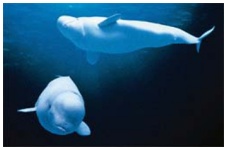
 The Lively Chatter of Sea Canaries Beluga whales are small (3-5 meters / 10-16 feet), toothed whales that inhabit coastal waters in Arctic and Sub-Arctic areas. They gather in pods of dozens or even hundreds of whales at major feeding grounds - such as where the Mackenzie River meets the Beaufort Sea. The term "beluga" comes from the Russian word "belukha" which means "white one". This whale is also referred to as "white whale", "white porpoise", "white squidhound" and "sea canary" - because of its lively chatter. Belugas can be recognized by their prominent rounded melon head, stout body shape, distinctive white color, and the lack of a dorsal fin. Instead of a fin, the whales have a dorsal ridge that runs from just behind the midpoint of the back to the tail flukes. A fin would impede their ability to swim just below the ice to locate and use breathing holes. Although we know the belugas as the "white" whales, their color actually varies with age. Calves are reddish-brown at birth but during their second year this slowly transforms to a marbled blue gray. In the following three years the color slowly fades as pigment is lost from the skin and they get their creamy white adult color.
Click pictures for more information and credits. Library: Arctic, Whales/Fish Links: Arctic, Arctic Animals Arctic Maps & Weather Reports |

|
DICTIONARY: Just "double-click" any unlinked word on this page for the definition from Merriam-Webster's Student Electronic Dictionary at Word Central. |

|
ARCTIC LIBRARY & GLOSSARY: Check this section for an index of the rest of the things you really need to know about the Arctic. |

|
ARCTIC MAPS & WEATHER REPORTS: Maps of the Northwest Passage, explorers' routes, iceberg sources, Nunavut, the Arctic by treeline, temperature... |

|
ARCTIC LINKS: Even more information! Links to sites related to the Arctic and "Iceberg: the Story of the Throps and the Squallhoots". |

|
GUIDE TO ARCTIC SUNRISE & SUNSET: How much sunlight or darkness is there in the Arctic on each day of the year? |
to is the property of their respective owners, and Athropolis is not responsible for their content.